One, in a literal term, it is a number.
However, to HTC, it is a branding strategy - the foundation that the entire
company is based on. Just look at the One series and you'll probably comprehend
easily that this is the pride and boast of the manufacturer. There is a very
good reason for that: in the cramped smartphone market, HTC is overshadowed by
giant guys such as Samsung and Apple. The company needs to be prominent if it
wants a chance to prove itself towards customers.
The One X marked a steady start, and while
it did not get the momentum CEO Peter Chou would have desired, the next model -
simply called the One – raise the ability to design and take photos of the HTC
up to the next level by releasing a new UltraPixel camera sensor, among other
top-leading specs. But has it attracted the eyes of potential smartphone
customers, with another important product launch? We think that it has received
more than a fighting chance.
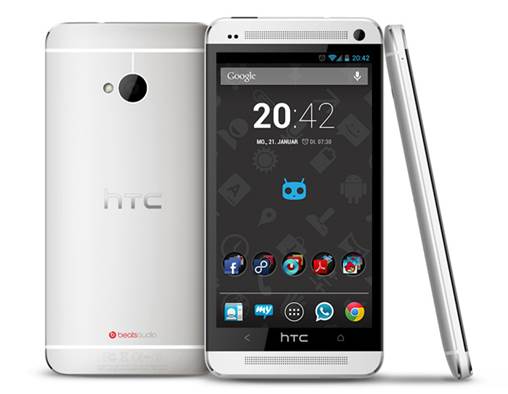
HTC
One 2013
Hardware
To fully appreciate the One’s hardware, you
first need to understand the process that takes place behind the scenes. Rather
than choose a polycarbonate shell used on the One X and One X+, HTC crafted the
One from a unique block of anodized aluminum, decorated with polycarbonate
accents throughout. It is extremely complicated: each unit must spend at least
200 minutes cut by the CNC machine, and the aluminum is etched into the
channels filled with polycarbonate - a technique known as zero-gap injection
molding. Adding the delicate edges that connect the sides of the phone to the
glass (Gorilla Glass 2, to be specific); and you have a phone with one of the
best industrial designs we have ever seen. The volume of detail is amazing
here, and it reflects how important this device is to the future of HTC.
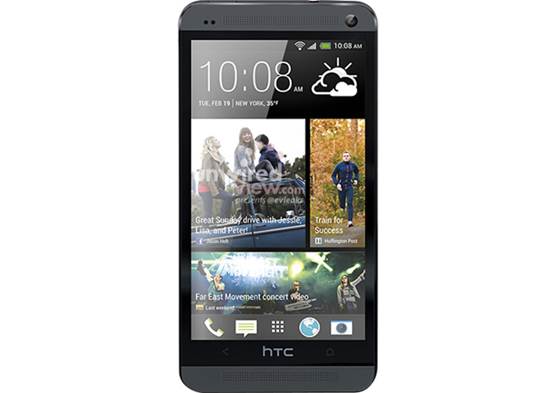
HTC
crafted the One from a unique block of anodized aluminum, decorated with
polycarbonate accents throughout.
It is much like the Windows Phone 8X and
Droid DNA (internationally known as the Buttefly); the One’s inside is set up
like the pyramid: the larger components such as screen and battery lie in the
front, with progressively smaller components when you move towards the back of
the device. This helps to create the rear shell a beautiful curve that makes it
extremely comfortable to hold. Although the One is even thinner with 9.3mm
(0:37 inches) than the 10mm (0.4 inch) of 8X, it is easier to hold since the
edges are bordered in the natural way. With 5:04 ounces (143g), it feels a bit
heavier, but lighter than what you may have thought, it's actually quite light
based on the materials used.

The
One’s inside is set up like the pyramid: the larger components such as screen
and battery lie in the front, with progressively smaller components when you
move towards the back of the device. This helps to create the rear shell a
beautiful curve that makes it extremely comfortable to hold.
After all, we love the design of the One
for every reason: it's attractive, it feels certain in the hand and the
combination of monolithic aluminum and polycarbonate makes sure that your phone
will not be broken into a million pieces if it is dropped down the ground
(although it may be dinged, or scratched up a little, depending on the angle).
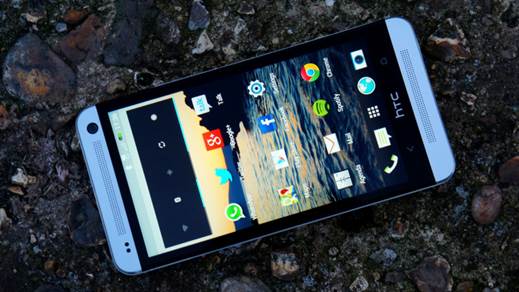
The
aluminum strips are arranged the top and bottom of the phone’s surface, with a
set of BoomSound speaker grilles that are designed to provide stereo sound when
you're watching movies or listening to music.
While industrial design, safety and
performance and build quality are a good start, there are many other things
about this thin aluminum plate. The front of the device is where some of the
biggest changes stay, highlighted by a 4.7-inch S-LCD3 screen with 1080p
resolution and two capacitive soft keys underneath it - a deviation from the
standard three-button setup. A small HTC logo is located where the home button
was once, right between the two soft keys. In fact, it's almost a bit
disappointing: the logo looks as if it would take charge of the role of the
button (we would enjoy it more), but unfortunately there is nothing else to hit
our eyes. The aluminum strips are arranged the top and bottom of the phone’s
surface, with a set of BoomSound speaker grilles that are designed to provide
stereo sound when you're watching movies or listening to music. (The grille
setup is like what you'll see the two sides of a laptop keyboard). An LED
notification light sits under the top grille, towards the left. A 2.1MP
wide-angle, front–facing camera is located in the top right corner, while the
two sensors are located on the upper left.
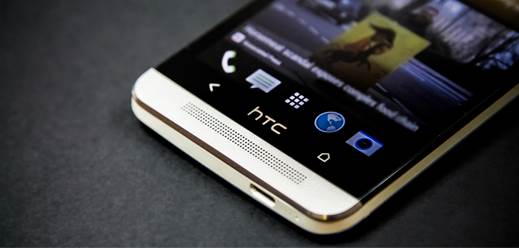
A
small HTC logo is located where the home button was once, right between the two
soft keys. In fact, it's almost a bit disappointing: the logo looks as if it
would take charge of the role of the button.
The front is the most crowded place on the
phone, while the sides and back have a more minimal build that helps to make
the phone look elegant. The polycarbonate-bordered sides tilt inward until they
meet the Gorilla Glass on the front, with only a bezel to connect them. The
left side is not interrupted, except for a micro-SIM tray and small ejection
port. A micro-USB/MHL port and mic lie on the bottom, and the right side is
occupied by a unique volume rocker which uses the exterior shell similar to the
Droid DNA.
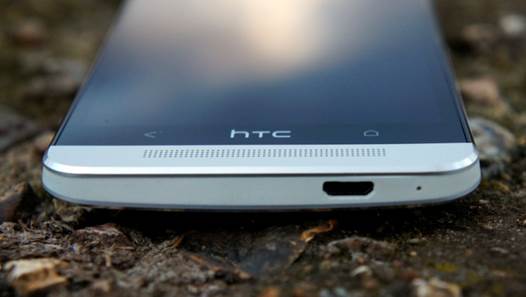
The
polycarbonate-bordered sides tilt inward until they meet the Gorilla Glass on
the front, with only a bezel to connect them.